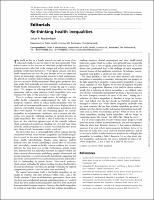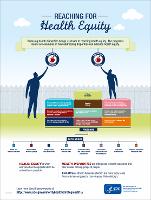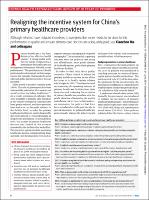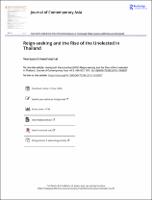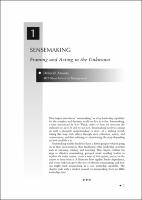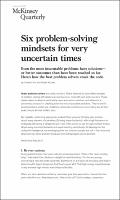Browsing by Title
Now showing items 225-244 of 299
-
Re-thinking health inequalities
(Oxford University Press on behalf of The European Journal of Public Health, 2020-06-19) -
Reaching for Health Equity
(US CDC, 2016) -
Realigning the incentive system for China’s primary healthcare providers
(BMJ, 2019-06-21) -
Refining index to measure physical activity inequality: which group of the population is the most vulnerable?
(2022-08-31)
Background: The existing body of research mostly discusses inequality in physical activity (PA) based on the difference in the level of moderate-to-vigorous physical activity (MVPA). Evidence is lacking on the quantified inequality measures (e.g., how big the inequality is, and the distribution) in order to identify the most vulnerable groups of a population. This study measured PA inequality among Thai adults by using three parameters to construct an inequality index: (1) Proportion of the population with sufficient MVPA; (2) Cumulative minutes ... -
Regional strategy on health system strengthening and primary health care
(Manila : WHO Regional Office for the Western Pacific, 2010) -
Reign-seeking and the Rise of the Unelected in Thailand
(Journal of Contemporary Asia, 2016)
This article develops the concept of “reign-seeking” to capture the unprecedented collective action of the Thai professional and official elite prior to the 2014 military coup and the establishment of a military regime. It argues that this phenomenon reflects broad and deep political dynamics, for which the dominant scholarship on authoritarianism and Thai politics cannot adequately explain. The changing incentives of these supposedly non-partisan actors are interwoven with neo-liberal governance reform driven by a desire for depoliticisation and ... -
Report card grades on physical activity for children and adolescents from 18 Asian countries: Patterns, trends, gaps, and future recommendations
(2022-10-29)
Background/Objective: Physical inactivity is a persistent and worsening population health concern in Asia. Led by the Active Healthy Kids Global Alliance, Global Matrix (GM) initiative provides an opportunity to explore how regional and cultural differences across 18 Asian countries relate to physical activity (PA) participation among children and adolescents. The purpose of study was to synthesize evidence from the GM2.0 to GM4.0 (2016–2022) in Asian countries. Methods: Report Card grades on behavioral/individual and sources of influence ... -
Resilience and Health-Related Quality of Life among Hepatitis C Patients in Pahang, Malaysia
(2022-01-01)
Background: Hepatitis C is one of the most common causes of liver disease worldwide. Health impacts of hepatitis C are not limited to physical morbidity but include psychosocial dimensions such as quality of life (QOL), depression, anxiety, and stigmatization. In Malaysia, modifiable factors that can improve QOL among hepatitis C patients have not been adequately studied. Resilience – defined as the capacity to endure hardships and rebound from life adversities – is associated with mental health and well-being. Our study aims to test the association ... -
Rethinking society for the 21st century: Report of the International Panel on Social Progress
(Cambridge University Press, 2018) -
Risk Communication Distributed among Migrant Workers during the COVID-19 Crisis in Thailand: Analysis on Structural and Networking Gaps
(2022-10-12)
Language and cultural barriers among migrant workers hamper access to health risk information. This study aims to explore health risk communication structure and processes and identify the communication network of migrant workers during the COVID-19 pandemic in Thailand. This study used a parallel mixed-methods design combined with in-depth interviews and questionnaires for social network analysis from November 2020 to June 2021 in the headquarter district of Samut Sakhon, Ranong, and Phuket provinces. We conducted purposive sampling of representatives ... -
Saving babies’ lives (SBL) – a programme to reduce neonatal mortality in rural Cambodia: study protocol for a stepped-wedge cluster-randomised trial
(2021-09-07)
Background: Neonatal mortality remains unacceptably high. Many studies successful at reducing neonatal mortality have failed to realise similar gains at scale. Effective implementation and scale-up of interventions designed to tackle neonatal mortality is a global health priority. Multifaceted programmes targeting the continuum of neonatal care, with sustainability and scalability built into the design, can provide practical insights to solve this challenge. Cambodia has amongst the highest neonatal mortality rates in South-East Asia, with rural ... -
Saving more lives on time: Strategic policy implementation and financial inclusion for safe abortion in Indonesia during COVID-19 and beyond
(2022-09-06)
Abortion is common in Indonesia, with 79% being unsafe. Unsafe abortion is one of the top five causes of maternal deaths globally. Meanwhile, in Indonesia, the maternal mortality rate (MMR) is still high, with up to 30% of it being related to unsafe abortion. In the COVID-19 pandemic, the number of unsafe abortions is expected to increase along with a 15–30% increase in unintended pregnancies. This will add to the number of maternal deaths on top of direct deaths caused by COVID-19. In Indonesia, access to safe abortion is still limited based on ... -
Self-assessment of attitudes towards conditions to provide safe abortion among new medical graduates in Thailand, 2018: an application of cross-sectional survey with factor analysis
(2021-07-21)
Background: Unsafe abortion is one of the major public health problems in Thailand. Although the penal code of Thailand and the Thai Medical Council permit doctors to perform safe abortion in certain conditions, little is known about the attitudes that new medical doctors have towards abortion. The objectives of this article are to explore the attitudes towards abortion in certain conditions among new medical graduates and to identify factors related to those attitudes. Methods: A cross-sectional survey was conducted in 2018 among 2017 medical ... -
The selfawareness questionaire
(2019-02) -
Sensemaking: framing and acting in the unknown
(2012)
This chapter introduces “sensemaking” as a key leadership capability for the complex and dynamic world we live in today. Sensemaking, a term introduced by Karl Weick, refers to how we structure the unknown so as to be able to act in it. Sensemaking involves coming up with a plausible understanding—a map—of a shifting world; testing this map with others through data collection, action, and conversation; and then refining, or abandoning, the map depending on how credible it is. Sensemaking enables leaders to have a better grasp of what is going ... -
Sexual and reproductive health literacy of school adolescents in Lao PDR
(2019-01-16)
Rationale: Adolescent pregnancy in Lao PDR is the highest in Southeast Asia. It leads to negative health and social consequences in young people. It is anticipated that this problem is partly caused by limited sexual and reproductive health literacy (SRHL), leading to poor sexual and reproductive health (SRH) decisions. Based on the concept of health literacy, SRHL goes beyond knowledge and behavior and is the self-perceived ability of an individual to access the needed information, understand the information, appraise and apply the information ... -
Singapore's migrant workers struggle to get paid
(CNN, 2018) -
Six problem-solving mindsets for very uncertain times
(McKinsey Quarterly, 2020-09) -
Social capital in the prevention and management of non-communicable diseases among migrants and refugees: a systematic review and meta-ethnography.
(2021-12-05)
Globally, the burden of non-communicable diseases (NCDs) falls disproportionately on underserved populations. Migrants and refugees are particularly vulnerable due to economic instability and systemic poverty. Despite the myriad of health risks faced by migrants and refugees, access to appropriate healthcare is hindered by structural, cultural and socioeconomic barriers. We conducted a systematic review and meta-ethnography to obtain critical insight into how the interplay of social capital and structural factors (eg, state policies and socioeconomic ... -
The social determinants of chronic disease management: perspectives of elderly patients with hypertension from low socio-economic background in Singapore
(2019-01-03)
Background: In Singapore, the burden of hypertension disproportionately falls on the elderly population of low socio-economic status. Despite availability of effective treatment, studies have shown high prevalence of sub-optimal blood pressure control in this group. Poor hypertension management can be attributed to a number of personal factors including awareness, management skills and overall adherence to treatment. However, these factors are also closely linked to a broader range of community and policy factors. This paper explores the perceived ...

